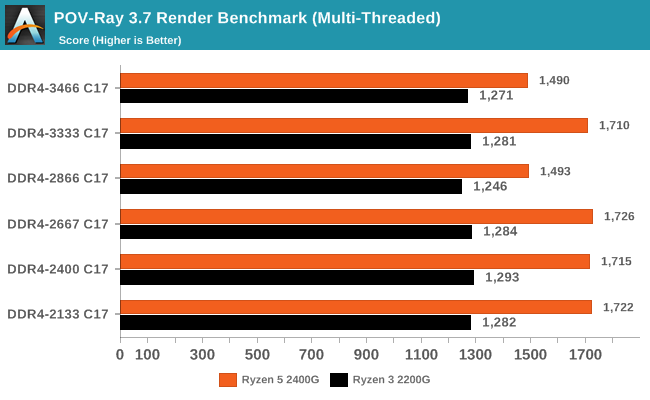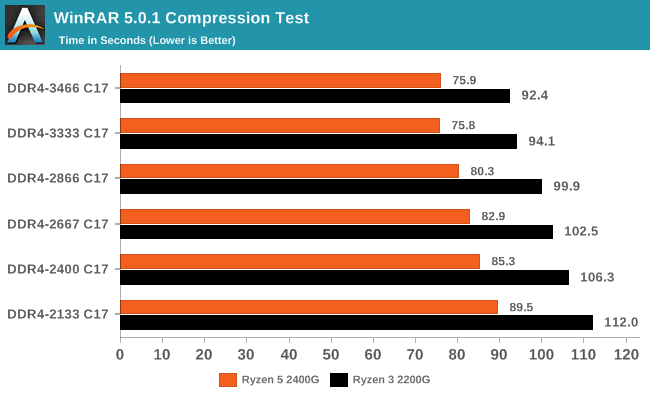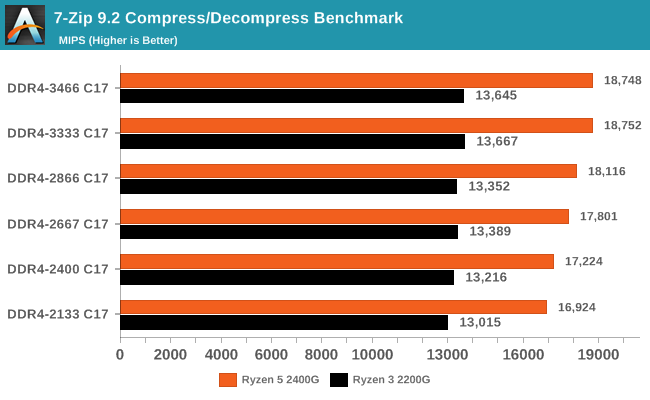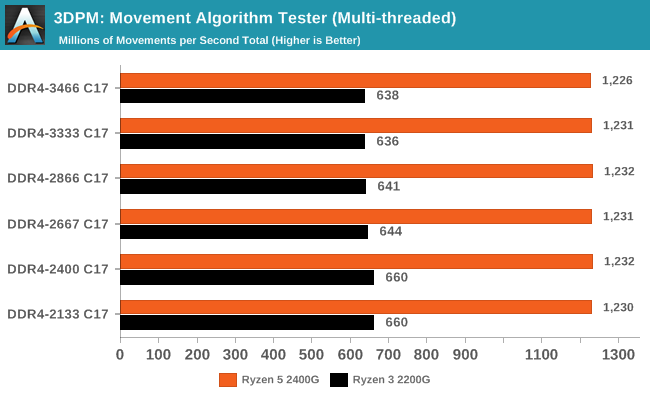Zen and Vega DDR4 Memory Scaling on AMD's APUs
by Gavin Bonshor on June 28, 2018 9:00 AM EST- Posted in
- CPUs
- Memory
- G.Skill
- AMD
- DDR4
- DRAM
- APU
- Ryzen
- Raven Ridge
- Scaling
- Ryzen 3 2200G
- Ryzen 5 2400G
CPU Performance
Rendering - Blender 2.78: link
For a render that has been around for what seems like ages, Blender is still a highly popular tool. We managed to wrap up a standard workload into the February 5 nightly build of Blender and measure the time it takes to render the first frame of the scene. Being one of the bigger open source tools out there, it means both AMD and Intel work actively to help improve the codebase, for better or for worse on their own/each other's microarchitecture.

While memory speed does influence our final rendering duration consistently by shaving seconds off, the jump from DDR4-2133 to DDR4-3333 equates to a 2% reduction overall on the Ryzen 3 2200G, although the last step from 3333 to 3466 is actually a regression. The Ryzen 5 2400G experienced a reduction of just under 4%.
Rendering – POV-Ray 3.7: link
The Persistence of Vision Ray Tracer, or POV-Ray, is a freeware package for as the name suggests, ray tracing. It is a pure renderer, rather than modeling software, but the latest beta version contains a handy benchmark for stressing all processing threads on a platform. We have been using this test in motherboard reviews to test memory stability at various CPU speeds to good effect – if it passes the test, the IMC in the CPU is stable for a given CPU speed. As a CPU test, it runs for approximately 1-2 minutes on high-end platforms.

Our results in POV-Ray 3.7 were a little hit and miss and showed irregularities at different memory clock speeds, perhaps due to the additional power required by the memory controller at higher frequencies taking away from available CPU power. This means POV-Ray isn’t really influenced more by the memory speeds themselves, although it is certainly more determined from more CPU cores and higher frequencies as the difference between the 2200G and 2400G show.
WinRAR 5.4: link
Our WinRAR test from 2013 is updated to the latest version of WinRAR at the start of 2014. We compress a set of 2867 files across 320 folders totaling 1.52 GB in size – 95% of these files are small typical website files, and the rest (90% of the size) are small 30-second 720p videos.

As the memory frequency was increased, the compression time was consistently lower going up a memory strap. With WinRAR being one of our most DRAM-affected CPU tests, we have seen this before with other CPU generations. The 2200G saw a 21% increase in throughput, while the 2400G had a +18% gain. However it is worth noting that the DDR4-3466 time was slightly slower than that of the DDR4-3333 time again.
7-Zip 9.2: link
As an open source compression tool, 7-Zip is a popular tool for making sets of files easier to handle and transfer. The software offers up its own benchmark, to which we report the result.

The 7-Zip results are interesting as with both Ryzen based APUs at the DDR4-3333 setting saw the biggest benefit in compression and decompressing. Again, the top strap in our testing was not the most performant. Overall gains were +11% for the 2400G, and +5% for the 2200G, in line with thread counts.
Point Calculations – 3D Movement Algorithm Test: link
3DPM is a self-penned benchmark, taking basic 3D movement algorithms used in Brownian Motion simulations and testing them for speed. High floating point performance, MHz, and IPC win in the single thread version, whereas the multithread version has to handle the threads and loves more cores. For a brief explanation of the platform agnostic coding behind this benchmark, see my forum post here.

With our 3DPM Brownian Motion simulator benchmark, memory frequency made little difference in increasing performance, although as our results show, the slower the memory, the better performance we experienced on the Ryzen 3 2200G. The Ryzen 2400G experienced a similar range of inconsistent and inconsequential results showing little to no improvement as the memory strap was increased.
Neuron Simulation - DigiCortex v1.20: link
The newest benchmark in our suite is DigiCortex, a simulation of biologically plausible neural network circuits, and simulates activity of neurons and synapses. DigiCortex relies heavily on a mix of DRAM speed and computational throughput, indicating that systems which apply memory profiles properly should benefit and those that play fast and loose with overclocking settings might get some extra speed up. Results are taken during the steady state period in a 32k neuron simulation and represented as a function of the ability to simulate in real time (1.000x equals real-time).

DigiCortex experienced a very subsequent increase throughout the tested memory straps on both the Ryzen APUs, with a nice jump in performance of 22% on the 2200G and on the 2400G.










74 Comments
View All Comments
invasmani - Tuesday, July 10, 2018 - link
We really need quad channel memory to become mainstream on low end CPU's ideally and octa channel or even six channel or example to become more affordable on mid range ones. The ram itself performance increases are slowly so we need to run more parallel memory channels similar to CPU cores like Ryzen has done well with.peevee - Thursday, June 28, 2018 - link
"With the aim being to procure a set of consistent results, the G.Skill Ripjaws V DDR4-3600 kit was set to latencies of 17-18-18-38 throughout"By doing that, you essentially invalidated the test as in real life lower frequencies mean lower values for those latency-inducing parameters, reducing the impact of frequencies.
edzieba - Thursday, June 28, 2018 - link
Setting a constant CAS actually increases the impact on latency compared to most RAM available. CAS is a clock-relative measure, and normally you will see CAS latencies rise as clockspeeds rise. This means real-time latencies (nanoseconds) stay surprisingly flat across clock frequencies. Only if you pay the excruciating prices for low-CAS high-clock DIMMs (in which case, why on earth are you using them with a budget APU?) do you start to see appreciable reductions in access latency.Of course, higher clock rates means more access /granularity/ even if latency is static so it depends on what your workload benefits from.
peevee - Thursday, June 28, 2018 - link
That was exactly my point. You you can run CAS 17 at 3466, you can CAS 12 or 13 at 2133, even on much less expensive memory. And then difference in the results will be much less.As surprising as it might seem, the memory latencies for a while hit the limitations of speed of electromagnetic wave in the wires, and the only solution (both for latencies and energy consumption) with those outdated Von Neumann-based CPU architectures is to do PIP, like in the phones, instead of DIMMs/SODIMMs.
mode_13h - Thursday, June 28, 2018 - link
I've been hoping to see HBM2 appear in phones and (at least laptop) CPUs for a while, now.peevee - Tuesday, July 3, 2018 - link
HBM2 has nothing to do with it.Phones actually get it right, they usually have memory in stacked configuration with CPU reducing the length of the wires to the minimum. Or at least set the memory chips close to the CPU. Desktop CPUs using DIMMs are hopeless. They could have improved things with a special CPU slot which would accept DIMMs (or better yet SODIMMs) in square configuration, like this:
*DIMM*
D|--C--|D
I-||--P--|I
M|--U--|M
M|------|M
*DIMM*
peevee - Tuesday, July 3, 2018 - link
The best for the DIMMs would be to lie flat, and CPU has 4 memory channels with pins on each side for each channel. Best of all would be LPDDR4x, with 0.6V signal voltage, would save a bunch for the whole platform. Something like 4-channel CL4 1866 or 2133 would have plenty of bandwidth and properly low latency, maybe even LLC will not be needed for 4 cores or less.peevee - Tuesday, July 3, 2018 - link
..."would save a bunch" of power...Lolimaster - Friday, June 29, 2018 - link
The thing is DDR4 3000 CL15 barely cost a few buck over 2400 CL15.Lolimaster - Friday, June 29, 2018 - link
All memory even cheapo 2133 are in the range of 165-180. Only CL14 3200 is above $200.